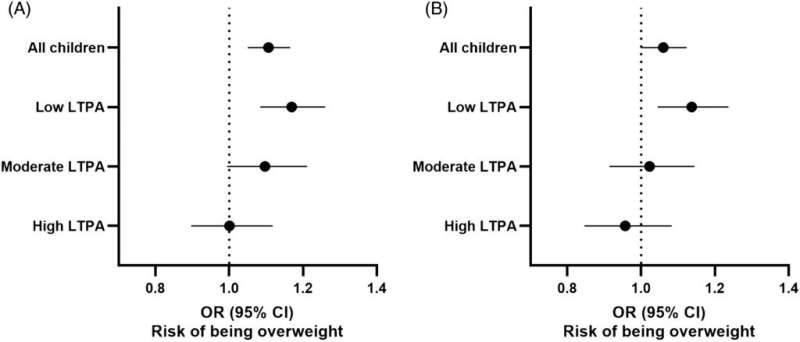Physical activity protects children from the adverse effects of digital media on their weight later in adolescence

Children's heavy digital media use is associated with a risk of being overweight later in adolescence. Physical activity protects children from the adverse effects of digital media on their weight later in adolescence.
A recently completed study shows that six hours of leisure-time physical activity per week at the age of 11 reduces the risk of being overweight at 14 years of age associated with heavy use of digital media.
Obesity in children and adolescents is one of the most significant health-related challenges globally. A study carried out by the Folkhälsan Research Center and the University of Helsinki investigated whether a link exists between the digital media use of Finnish school-age children and the risk of being overweight later in adolescence. In addition, the study looked into whether children's physical activity has an effect on this potential link.
The results were published in the Journal of Physical Activity and Health.
More than six hours of physical activity per week appears to reverse adverse effects of screen time
The study involved 4,661 children from the Finnish Health in Teens (Fin-HIT) study. The participating children reported how much time they spent on sedentary digital media use and physical activity outside school hours. The study demonstrated that heavy use of digital media at 11 years of age was associated with a heightened risk of being overweight at 14 years of age in children who reported engaging in under six hours per week of physical activity in their leisure time. In children who reported being physically active for six or more hours per week, such a link was not observed.
The study also took into account other factors potentially impacting obesity, such as childhood eating habits and the amount of sleep, as well as the amount of digital media use and physical activity in adolescence. In spite of the confounding factors, the protective role of childhood physical activity in the connection between digital media use in childhood and being overweight later in life was successfully confirmed.
Activity according to recommendations
"The effect of physical activity on the association between digital media use and being overweight has not been extensively investigated in follow-up studies so far," says Postdoctoral Researcher Elina Engberg.
Further research is needed to determine in more detail how much sedentary digital media use increases the risk of being overweight, and how much physical activity is needed, and at what intensity, to ward off such a risk. In this study, the amount of physical activity and use of digital media was reported by the children themselves, and the level of their activity was not surveyed, so there is a need for further studies.
"A good rule of thumb is to adhere to the physical activity guidelines for children and adolescents, according to which school-aged children and adolescents should be physically active in a versatile, brisk and strenuous manner for at least 60 minutes a day in a way that suits the individual, considering their age," says Engberg. In addition, excessive and extended sedentary activity should be avoided.
More information: Elina Engberg et al, Physical Activity Among Preadolescents Modifies the Long-Term Association Between Sedentary Time Spent Using Digital Media and the Increased Risk of Being Overweight, Journal of Physical Activity and Health (2021). DOI: 10.1123/jpah.2021-0163




















